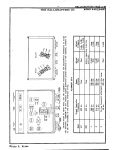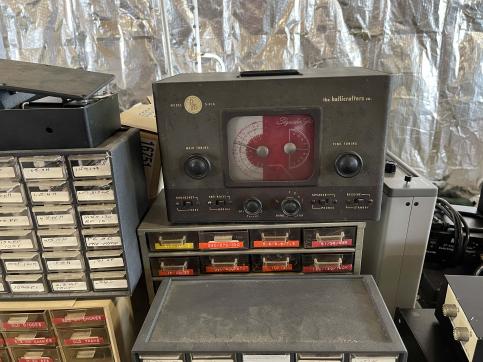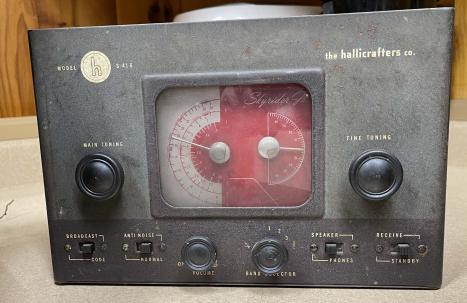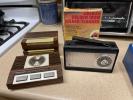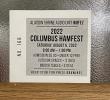- 2022
- Aug
- 31
Blonder-Tongue Audio Baton (BT B-9) Schematics
A few months ago, I posted about some Blonder-Tongue Audio Baton (Blonder-Tongue B-9) units that I’d rebuilt some years ago. Those units, unfortunately, are long gone but I knew I still had the Sams Photofacts schematic laying around somewhere, and I thought that if I could find it, I’d scan and post it for anyone else who has an interest in these devices.
I was able to locate that documentation, and you can download a copy of it as a zip file or a 7z file. The 7z is a little smaller than the zip file, the zip being about 58MB. The schematics are 600DPI .bmp files for maximum clarity. I also host that on wereboar, you can grab that from https://wereboar.com … Baton%20SAMS.pdf.zip
I’m pretty sure I had a scan of the original manual as well, if I can locate that I’ll post it as well.
Manual: https://wereboar.com … ton%20Manual.pdf.zip
If you happen to know where the units in the pictures are, I’d love to know.
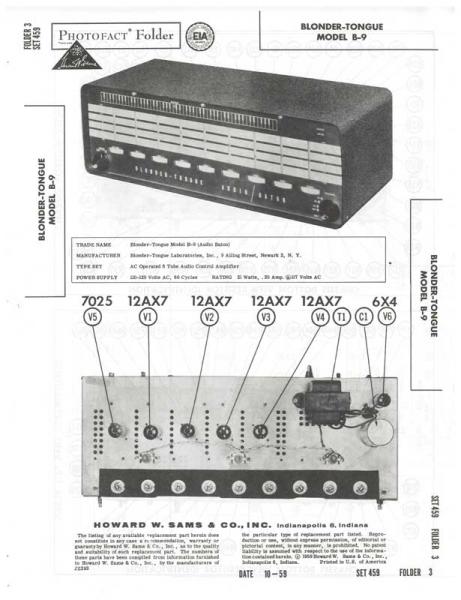
- 2022
- Aug
- 27
email misadventures - security is important!
What happened?
About a year ago, I swapped my domains over to a new registrar. The old one had become stale and was gaining a weird reputation, and they had cut their extremely attractive email plans down to crap Outlook plans. The final straw was when the free-with-reg email they provided was stopped. They charged for things like domain privacy, and it was just becoming more expensive than it was worth.
The new registrar had a better email plan using a non-Outlook service, offered free domain privacy and relatively inexpensive website SSL, so the choice was clear. However, the email plans didn’t auto-config as well as they claimed.
I knew there was something screwy with my email. Gmail, the great Satan of services (but if Google likes you, everyone does) would sometimes tell me that it couldn’t verify my email was sent by pygg.xyz. That TLD is somewhat suspect due to it’s use by spammers, but that wouldn’t cause a warning to happen, it would just bounce as spam. Something else was wrong. It finally came to a head when I tried to send a mail to a particularly tight system and it bounced as blocked.
I learned three new things: SPF, DMARC, and DKIM.
In the examples below, some personally identifying or secure information has been blurred, so do not use these as your own records.
SPF
SPF is a term that stands for “Sender Policy Framework.” It looks something like this:
![]()
This record is not one of the main named types used in Internet routing, so it simply gets a type of “TXT,” or as you probably guessed, text. The 1200 is the TTL (Time to live) which I simply left at the default.
What this record means, is that for my mail service of privateemail.com, mail coming from my domain of pygg.xyz is allowed to send mail. It’s simple “match this” mechanism, and it generally works as it’s a yes/no thing. Other mail is quarantined for inspection, which is what the ‘~all’ means. It’s called a softfail. The other option here is “-all” which means that any non-matching sender is rejected. This is called a hardfail. This can be dangerous if you’re not set up correctly, so I’ve left it as soft.
The vendor’s SPF record was orginally set up with a number of IPV4 addresses hard-coded in, which can be dangerous if the vendor’s address changes (such as adding new servers.) I found it better to match the mailserver’s name as opposed to it’s address. In this case, even if an address changes, you still match the name. I’m not sure, but it seems that the vendor may have had more mailservers than the record allowed. This fixed the SPF errors recorded by various testing services online.
DMARC
DMARC is a term that stands for “Domain-based Message Authentication, Reporting, and Conformance.” It looks like this:
![]()
This record is also not one of the named types, so it also gets a record type of TXT.
What this record means is simple. If someone tries to send email as you (i.e. spoofing,) the mailserver will take this action and send any suspicious mails to the addresses specifies. It works in conjunction with SPF and DKIM records. This record didn’t exist on my domain, so receiving servers looked at my email with a suspicious eye since they had no idea what my mail service did with spoofed. This record is one purely of self-policing trust. If I can’t take care of my affairs, it makes you less likely to deal with me. It was probably the most heavily weighted reason as to why I was being bounced.
To create this record, instead of wandering through what all of the options mean, I used a helper service. In particular, a site called dmarcian, located here: https://dmarcian.com … dmarc-record-wizard/. This leads you through all the things you need to fill out and automagically creates the record. It’s up to you to create the host and type, but you can follow mine or many other examples online.
One thing of note: You can either QUARANTINE or REJECT mail that doesn’t match your sending policy. There’s also another thing you can do, NONE - this means don’t do anything, just collect data. This is usually seen by receiving systems as a failure and is not suggested - it’s essentially the same as having no record at all.
DKIM
DKIM is the last thing that was messed up on my mail server, and part of it was my fault, part of it was the vendor’s fault. My fault was that, unless you’ve done this before, you have to trust that the vendor is giving you the correct information. As I had not done this before, I simply grabbed what was presented to me and pasted it in. That was wrong. The vendor didn’t clearly say that only a portion of what they presented was needed, and didn’t really mention that you had to append extra fields to use the long strings they generated.
DKIM is a term that stands for “DomainKeys Identified Mail”. It’s a public-private key pair that’s used to “sign” your emails and encode them, and if the receiving server can decode the mail with your public key, it’s assumed that you sent it since only you should have your key. It looks like this:

This record is an object that tells the receiving server what it is, what method to use during decoding, and what the actual key is. It’s (again) a TXT record, but this one has a single characteristic that is quite important. If you look at the first field, you’ll see “default._” - this is the object’s actual name, and MUST be used. In my case, the vendor used “default” as the object name when generating the key, although yours may be different. “s1”, “server1”, “bob” - whatever your vendor’s key generator uses MUST be used here as well. I didn’t understand that and used a name I found others mentioning, that of “s1”. This had the effect of the receiving server failing to find my key, as it was looking for “s1” and the server was using “default”. Changing the object’s name to “default” immediately fixed that and the remote server found the key and decrypted it.
My vendor also presented the key wrapped in a description that they created. That’s what really threw me off - when I pasted that in, remote sites still complained about a bad key, so I needed to determine the actual requirements of the key itself. The only parts of the key you need start at “v=DKIM” (the type of key) and end at the end of the actual key itself (the long string of characters.) Some sites suggested ending the record with a semicolon, so I did. I’m not sure if that’s needed, but it didn’t complain.
DKIM is a two-part thing on your end. You must have DKIM, and it must be valid. A receiver gives you a rating based on both. You can have a key, but if it’s invalid, that may still make your mail pass. Having both a key and a good key is imperative.
After that, I used some email test services that I found online. You send an email, and it analyzes the mail for proper construction. There are a number of those online. The only thing I can say about them is they are usually used for people who are sending newsletters, so they often analyze the content of the message and look for unsubscribe links. You can safely ignore those suggestions if you’re just setting up a personal email.
So what did I learn?
Modern email systems have a lot of security features that must be in place for other email systems to trust you. SPF, DMARC, and DKIM are all required, and even that may not save you.
For example, I’ve found out that my domain, which uses a TLD of .xyz, loses trust points simply for being an .xyz domain. Apparently, that’s used a lot for spammers, but there’s not much I can do about that. I can set my security up, and if you still don’t want to trust me then that’s your business, not mine.
What should you walk away with here?
This wasn’t meant to be a tutorial on how to set this stuff up, every email vendor has different ways of doing it and using my vendor’s system as an example is going to be useless for you. I mostly wanted to tell you about what you should look for when manually setting up your email system. It’s going to be up to you to learn how to implement those practices on your service.
Did the “tight” system accept your email afterwards?
No. It blocks .xyz wholesale, as best I can tell.
Gmail, on the other hand, now loves it and happily accepts it without error.
- 2022
- Aug
- 24
The Hallicrafters S-41G: Found the Sams folder.
While the Riders schematics are useful and have the proper alignment information, the Sams set simple excels in the parts listings for a device. This folder came from a well-known auction site, and is in remarkable shape for something from 1946. I probably paid a bit too much for it, but having this information is simply invaluable.
If you’d like to download the high-res scans of this set, along with the Riders images I posted earlier, you can do so with this link: https://app.box.com/ … 7cuc70d70xnay5dmusuq. This will open a box.com window, and you can either download the entire folder by clicking the “Download” button in the upper right corner, or go through the folders and pick and choose. It’s about 116MB, and contains BMP and PNG images.
You can download a .7z version of the archive here: https://privateemail … 43a07/1/8/NjQ/NjQvMw. This archive is smaller than the .zip version, if you’re trying to save bandwidth and space.
These images are reduced in size and quality so I could fit them without using up my server space. If you’d like the full resolution scans, be sure to use the box.com url above.
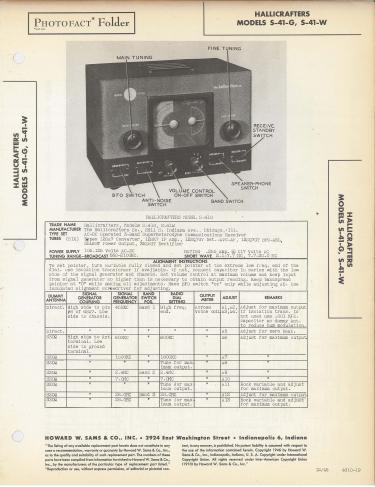
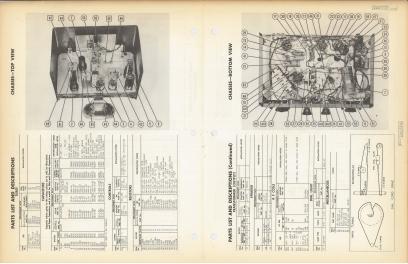

Now that I have an accurate parts list, I’m going to make a list of capacitors and resistors. I’ll probably just get them all and replace as needed.
- 2022
- Aug
- 11
The Findlay Radio Club Hamfest - September 11 2022.
This is always an excellent show, and is a “Dayton without the Dayton prices.” If you’re looking for something and it’s not here, chances are you didn’t need it!
Tickets, as always, are $10, and can be bought in advance (print it yourself) online. This year, it falls on Sunday, September 11th, and is usually a hot day. See you there!
Where:
Hancock County Fairgrounds
1017 E. Sandusky St., Findlay, OH 45840
When:
September 11th, 2022. 8AM to late afternoonish.
Tickets and location https://www.ticketta … layradioclub/712150#
- 2022
- Aug
- 11
The Hallicrafters S-41G: Found a schematic.
While I didn’t expect this to be difficult to find, I was pleasantly surprised to find the Rider’s available on Antique Electronic Supply’s website. AES has a nice selection of components for the radio enthusiast, I highly recommend them for restoration components.
Antique Electronic Supply’s website https://www.tubesandmore.com/
Now to start identifying what I need to make this thing sing again.
- 2022
- Aug
- 7
The Hallicrafters S-41G Skyrider Jr.
I’ve been looking for an AA5 “Shockbox” radio for a while now, but these seem to be getting kind of rare, which is odd considering how many of those things were made. So I’ve decided to instead look for an older multi-band unit. While this one wasn’t exactly what I wanted, it was cheap enough that it will work until I find a better example.
The Hallicrafters S-41G “Skyrider Jr.” was introduced right after WWII as a low-cost entry level receiver, alongside the company’s Echophone EC-1B which is electrically and mechanically identical. This unit lasted for a few years, and was replaced with the more common and more familiar S-38 line, which lasted for 6 models (S-38 through S-38E.)
This unit is in “acceptable” condition, and is complete with original knobs, a usable face, and limited damage to the chassis. It was purchased for $25 on August 6th, 2022 at the Columbus, Ohio hamfest.
When I first saw it, the friend I was with said “That looks like it sat around in a shop for years as the shop radio.” Turns out that was correct, the gentleman that sold it said it was in his father’s shop for years, but his father was unable to answer any questions about it, being in a state of mind that didn’t allow for much these days. That’s kind of sad to know I won’t be able to get any history, but that’s how it usually goes with these things.
First thing I did when I brought it home, of course, was to give it a quick lookover and then plug it in. Unsurprisingly, it came right up, and after getting the crud of the ages out of the switches, I was able to receive one of the strong local AM stations without any antenna connection. It must still be decently aligned.
The radio had the “science fiction squeal” as you turned the dial. Bad AGC capacitor, but that’s expected. Then the volume started dropping. Grid coupling capacitor was leaky and slowly allowing voltage through, cutting off the tube. I was about ready to turn if off, as I don’t want to destroy the tubes when it went POP and smoked. Capacitor blew out. Since the volume didn’t change, I expect it was the one across the line. But I rapidly pulled the plug anyway because it was shown to be working and that’s what I needed to see.
What’s a good initial showing without tearing the bottom off and baring the goods to the world? So that’s what I did next, and probably should have done first.
There were those big orange replacement filters. That was visible from the back, so no surprise. These were 450VDC capacitors with a 1974 date code, and decently installed. The voltage was far too high for the rectified line, but there are multiple schools of thought on this. One says go to the max, others say keep the voltage near the working voltage. The thought behind this is if you don’t give the capacitors their rated voltage, they can lose their ability to be a capacitor, and will try to “reform” and become capacitors again every time you apply voltage. I’ve always followed that rule, so a B+ of 150VDC probably would net a 200WVDC capacitor. In any event, these will go and get replaced with modern (and smaller) capacitors. Since these are nearing 50 years old themselves, it’s probably time regardless.
The other changes were the addition of a new line cord (sans the probably long dried out grommet in the chassis it went through) and a phone jack across the pin terminals originally placed by the factory. Not bad, usually these things are just a mess inside.
What’s going to happen next is the finding of a schematic. While I’d like to get the original Riders or Sams set for the radio, that may be difficult. There are a number of offerings online, so it’s just a matter of finding one that’s not a honeypot and downloading it. Then, the process of determining which parts need to be replaced begins - but that’s probably a job for this winter when the snow flies and the days are short. But check back in a few months for more on this set.
- 2022
- Aug
- 7
My haul from the 2022 Columbus Hamfest
I really need to stop doing this. What am I going to do with these things? HOARD THEM!
- 2022
- Aug
- 7
Pictures from the 2022 Columbus Hamfest
This year’s show was a bit muted - the sky threatened rain all day, and it did rain in several locations around the city. Fortunately, it held off at the Aladdin Shrine Temple, but still kept things low key. More vendors showed up as the morning went on, and the inside of the building was still fairly well packed as usual.
There was enough to keep me and a friend busy for almost 3 hours, and we found ourselves going back and forth as new people arrived. A few things I probably should have walked out with, but I have to be kind of choosy because I have too much junk already. Oh well…there’s always Findlay in a month!


